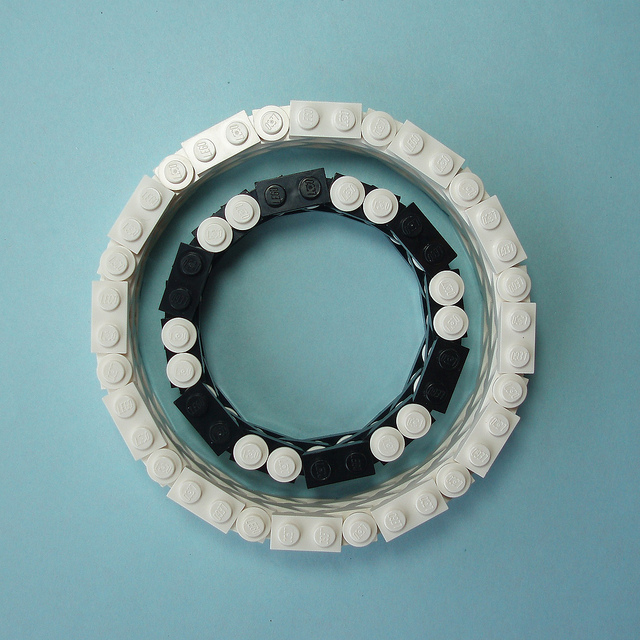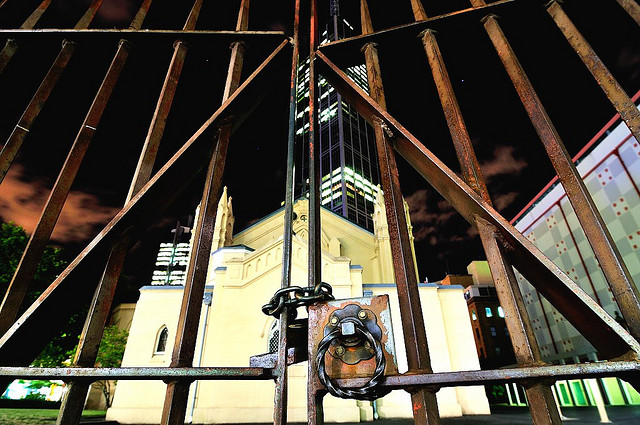The circle.
The circle is fundamental.
This simple shape, along with the square and the triangle, introduces our early minds to geometry, to symmetry, to physical and social design.
This past weekend I felt ashamed at Pagan Pride on account of a circle.

My body helped form the edge of a circle. My body stood next to other bodies — thirty perhaps — in the middle of one of the most public of spaces in all of Denver, Civic Center Park. This circle of bodies in the middle of my city, in the middle of a crowd of onlookers, did something I did not expect this circle to do.
It created an us and a them.
Casting circle before a crowd of people, some of whom were unsuspecting passers-by, and others virtually residents of the park, established a kind of religious exclusivity. It was as though we said, by joining hands and turning our backs to the crowd:
This is our circle. You are on the outside of this circle. We are doing our religious work on the inside.
The circle seemed to other the onlookers.
None of this was done explicitly. The leaders of the ritual, all good-hearted Pagans, did not inform the crowd that they were to remain outside, or that they were unwelcome in the ritual. They didn’t need to.
They’d invited us to come down for ritual, but the non-Pagans were not addressed. There was no clear explanation of what the ritual would be like, what might be expected of the participants, or — for those who weren’t familiar with Pagan (or more specifically, Wiccan/New Age-ish) rituals — what it would all mean.
The insiders were told that the ritual was going to raise power to bring us protection. The irony would be that this circle inspired the same antagonism and meanness from outside the circle from which the ritual was seeking to protect us.
There was heckling. It sounded like drunk heckling. Drunk, Christian heckling. And there were disruptions from a few men who, while we stood there in our circle, paced slowly around the perimeter. One asked for a cigarette. One stood outside the circle by about 5 feet and folded his arms across his chest.
The ritual leaders did not acknowledge any of this.
In response to the jeers and taunts, one ritual leader stood in solidarity inside the circle and began to talk to us about how protection was so important because there were people out there who didn’t understand us or respect us. It was as close to a “preaching” moment as you might find inside this kind of circle.
I heard her reassure us, and I thought,
But we just created an out there by casting this circle. We closed them off from us, shut them out, but only symbolically because they could see and hear all of what we were doing. Play it like we’re the victims, but we just created — through ritual — the same kind of alienation that we feel in relation to the greater society.
We just became The Church.

The rest of the ritual involved the distribution of smooth stones to each of us, stones which had been blessed and inscribed with a pentacle and the word, “protection.” These were our charms, we were told, to give us strength and to provide us protection as we leave the circle and go back into the world.
I found myself feeling so embarrassed. I kept looking down. I didn’t want protection from the people on the outside of the circle; I wanted to connect with them. To explain. To try to find some sort of understanding.
But it wasn’t my ritual.
To close, we imagined a ball of white light — the quintessential ball of white light — enveloping the circle, and then extending outward to include all of this place and all of the world. This imaginary light would attempt to do what we had not done with our physical bodies, which was to include all. In that moment our meditation, our magickal working, was an obvious self-deception; a willful ignorance of what was actually occurring in the space around us.
At least, that’s how it felt from where I was standing in the circle.
I don’t know about circles anymore. I don’t know if they’re appropriate to cast in these kinds of public settings. I doubt them in a way that I didn’t before Denver’s 2012 Pagan Pride.
I trust that many of you either cast circles, or have been in a ritual where one was cast. I wonder if you could shed some light on how you see them as useful, or how you find them to be problematic. Could you imagine other forms of ritual, ones that do not create a boundary between those on the outside and those within, that would feel appropriate at a Pagan gathering? Or, is this kind of “protective barrier” a necessity?
I felt ashamed at Pagan Pride because I was a part of something that felt, on account of the circle, incredibly exclusive. Could there be a more inclusive, perhaps even radically inclusive way of doing Pagan ritual in public?
Leave a Reply